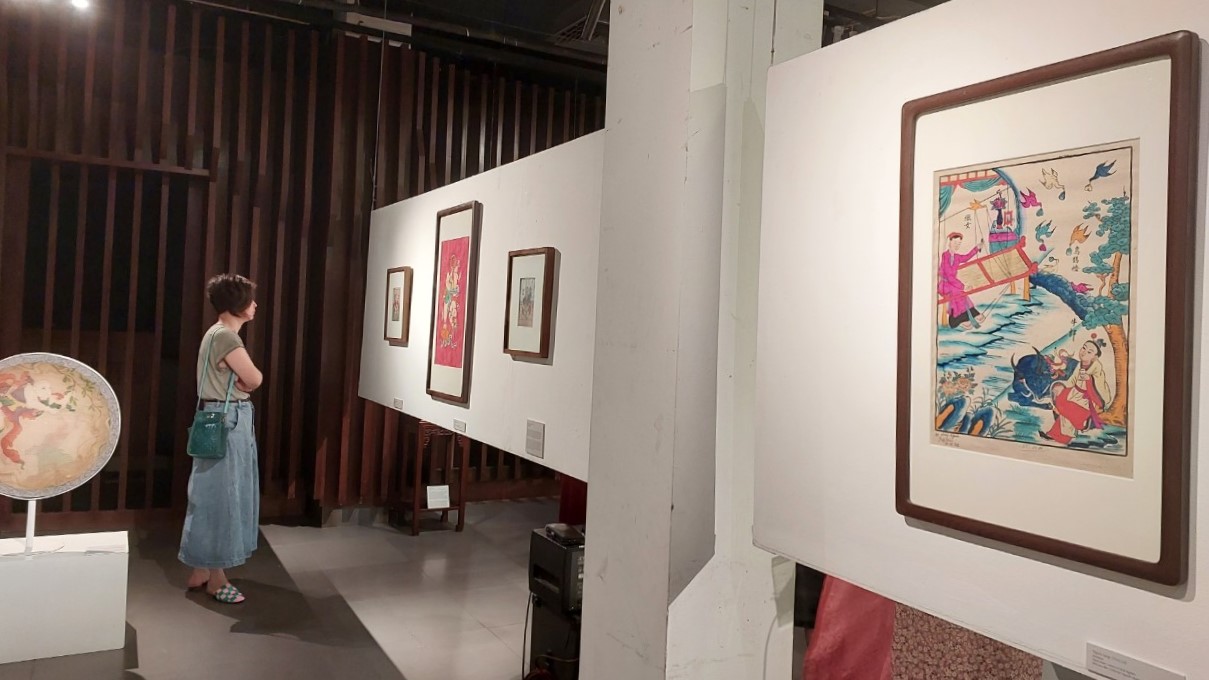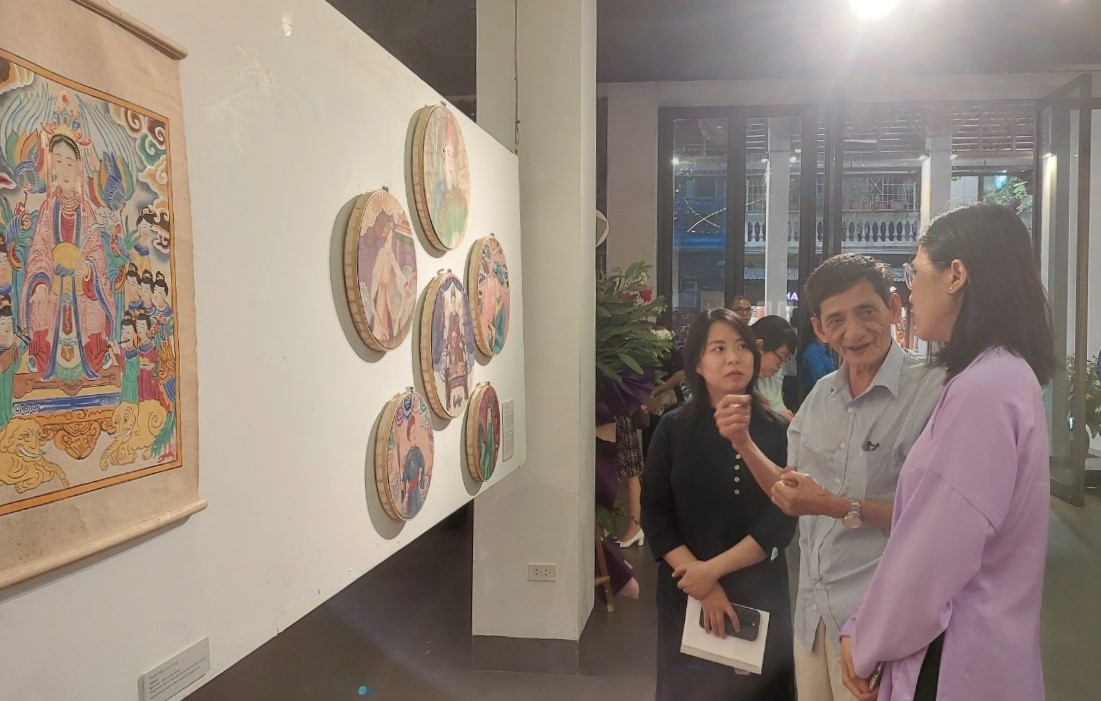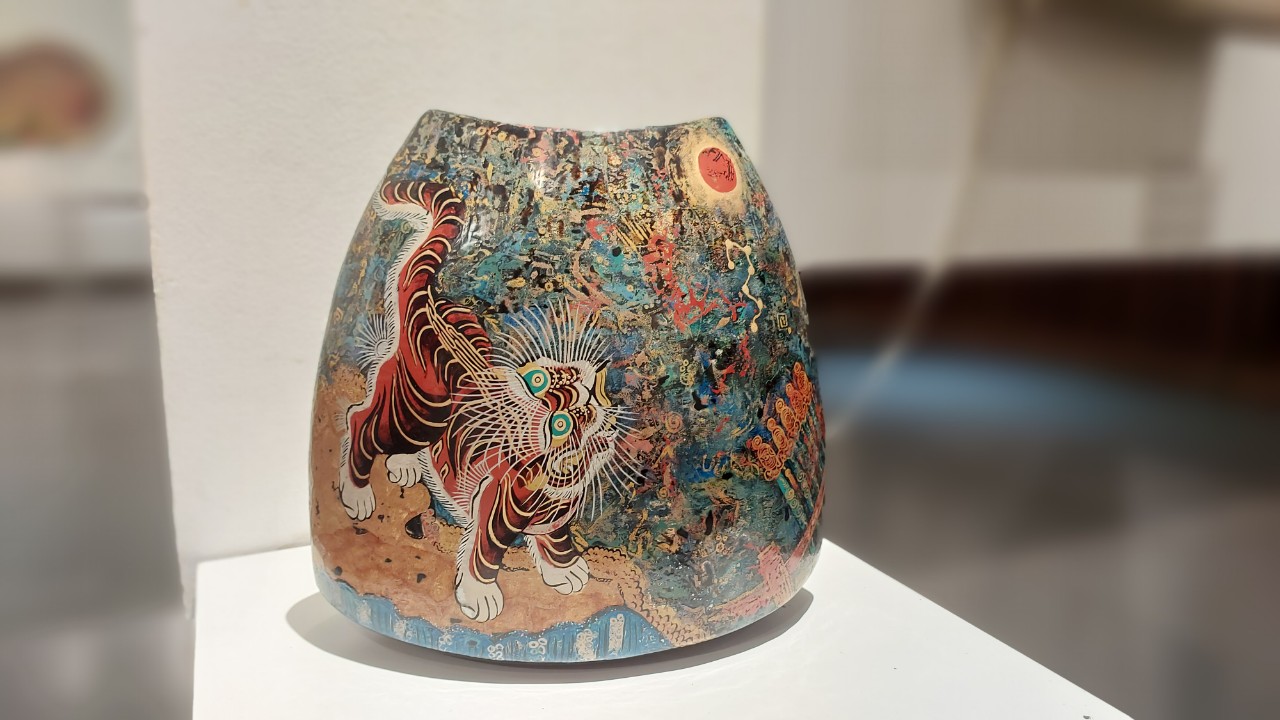Promoting the value of Hang Trong paintings by new experiments
Young artists have made efforts to preserve the value of traditional Hang Trong paintings using traditional art forms of Vietnam, such as lacquer and silk.
Hang Trong folk paintings are frequently used as Tet décor or worshipping objects. Few people know that these paintings also depict the landscape and cultural practices of the populace.
Visitors to the "Hang Trong folk paintings" exhibition, held by the People's Committee of Hoan Kiem District, can reflect on the daily lives of farmers in the picture Rest or the society in the past in miniature in the painting Western Festival.
Adding modernity to old art
These paintings by Hang Trong artisans were restored to the traditional standards by artisan Le Dinh Nghien, and now they are in possession of collector Nguyen Quang Trung.
The exhibition also features 23 works by young artists inspired by Hang Trong folk paintings. These pieces were created using many materials found in painter Nguyen The Son’s installation space.
| A visitor at the exhibition of Hang Trong folk paintings. Photo: Ngo Minh |
The exhibition is the result of artist Nguyen The Son’s latest effort, "From Tradition to Tradition" where young artists attempted to dialogue and uphold the value of traditional paintings using various Vietnamese painting materials such as lacquer and silk.
A group of young artists who majored in Lacquer and Silk at the Faculty of Painting, Vietnam University of Fine Arts acquired the technique from renowned artisan Le Dinh Nghien through the initiative.
According to painter Nguyen The Son, “the exhibition is an opportunity to introduce to the public the unique collection of Hang Trong paintings created by artisan Le Dinh Nghien as well as the new creations of young artists who are always interested in traditional heritage value,” said painter Nguyen The Son.
In his opinion, incorporating traditional culture into artistic practice is a smart way to protect and advance heritage values.
The famous Hang Trong paintings Ly Ngu Vong Nguyet (Carp Looks the Moon), Tam Da (Three Abundances), That Dong (Seven Children), and the fine details of the clouds and trees in the older Hang Trong paintings served as inspiration for the young painter Nguyen Cam Nhung and her co-worker’s folding screen.
In the artwork, the artists use a metaphor for a life of affluence, prosperity, richness, and fullness and one for ancestors' past and precious values. Besides, they use a gentle and condensed approach to add a modern touch to the depiction of trees, representing the dialogue between the present and the past.
“We want to introduce to visitors different perspectives on art practice as well as the connection between traditional and contemporary culture,” Nhung said, adding that the skill and passion for the traditional art of veteran craftsman Le Dinh Nghien greatly inspired her.
| Artisan Le Dinh Nghien talks to visitors at the exhibition. Photos: Ngo Minh |
Through the use of various traditional Vietnamese materials like lacquer and silk, painter Nguyen Thi Nhu Quynh’s lacquer vase Red Tiger General brings a very traditional, very Vietnamese style of Hang Trong paintings to the creation.
“After studying and observing, I believe that Hang Trong paintings and lacquer paintings share many similarities, from the color transitions to the meticulousness required when drawing. Especially lacquer can be used to contour the fine details of Hang Trong paintings. Therefore, to give Hang Trong's paintings new colors with multiple and cheerful tones, I portrayed some parts of the painting with lacquer. Hopefully, it will give viewers a fresh feeling," she said.
Renovated heritage
Talking to The Hanoi Times, artisan Le Dinh Nghien expressed his joy that the young generation's ancestral legacy is being preserved and spread.
“This exhibition features only 23 ancient paintings, a small portion of the heritage of Hang Trong folk paintings, but it is extremely valuable in my opinion, especially when Hang Trong paintings become the material and emotional inspiration for young people to create, develop and add their own artistic imprints,” said Le Dinh Nghien.
| A lacquer vase embracing the image of Hang Trong painting. |
Assessing the effort of young artists in renovating Hang Trong paintings, PhD Tran Hau Yen The expressed his astonishment at how seamlessly the exhibition combined the heritage element and the innovation factor.
“By applying other traditional materials of Vietnamese art, such as silk, lacquer into their creation, young artists have enhanced the value of Hang Trong folk paintings. In the old days, people used to paint on Poonah paper, but today’s young artists use various materials to make their works, such as folding screens, vases, recycled materials, and embroidery frames, among others,” commented Tran Hau Yen The.
Hang Trong painting is one of three typical folk paintings of Vietnam, named after Hang Trong Street, Hoan Kiem district, formerly in Tho Xuong district of Thang Long Capital (now Hanoi).
In Hang Trong folk paintings, painters use woodblock prints only to draw the major black contour lines that define the shapes. Hand coloring adds colors and tints that give the finished pieces more dimension.
The genre of Hang Trong paintings may have its last torchbearer in Master Le Dinh Nghien. He is now the only one who knows the trade from A to Z. He teaches old art to his son Le Hoan and other young artists.
Using a unique approach, researcher Tran Hau Yen The believes that Hang Trong folk paintings will have a different life and be used in a wider range of settings, with higher applicability in interior decoration and architecture.
The exhibition lasts until April 16 at the Hanoi Old Quarter Cultural Exchange Center, 50 Dao Duy Tu Street, Hoan Kiem District.















